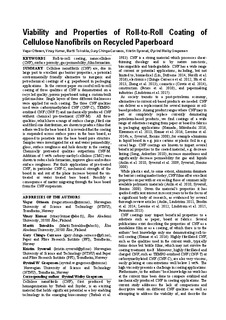Viability and properties of roll-to-roll coating of cellulose nanofibrils on recycled paperboard
Ottesen, Vegar; Kumar, Vinay; Toivakka, Martti; Chinga-Carrasco, Gary; Syverud, Kristin; Gregersen, Øyvind Weiby
Journal article, Peer reviewed
Accepted version

View/
Date
2017Metadata
Show full item recordCollections
Original version
10.3183/NPPRJ-2017-32-02-p179-188Abstract
Cellulose nanofibrils (CNF) are, due in large part to excellent gas barrier properties, a potential environmentally friendly alternative to inorganic and petrochemical coatings of e.g. paperboard in packaging applications. In the current paper successful roll-to-roll coating of three qualities of CNF is demonstrated on a recycled quality, porous paperboard using a custom-built pilot machine. Single layers of three different thicknesses were applied for each coating. The three CNF qualities used were carboxymethylated CNF (CNF-C), TEMPO- oxidized CNF (CNF-T) and mechanically produced CNF without chemical pre-treatment (CNF-M). All three qualities, which have a range of surface charge, fibril size and fibril size distribution, are shown to produce films that adhere well to the base board. It is revealed that the coating is suspended across surface pores in the base board, as opposed to penetrate into the base board pore structure. Samples were investigated for air and water permeability, gloss, surface roughness and hole density in the coating. Chemically pretreated qualities outperform CNF-M. Addition of 5 wt% carboxy-methyl cellulose (CMC) was shown to reduce hole formation, improve gloss and reduce surface roughness. For thick applications of pre-treated CNF, in particular CNF-C, mechanical strength of the board in and out of the plane increase beyond the un-treated or water treated base board. Possibly a consequence of matter migrating through the base board from the CNF suspension.